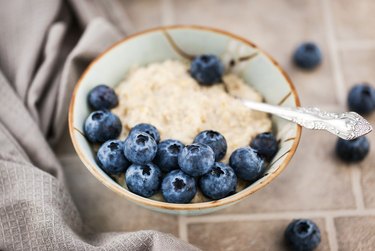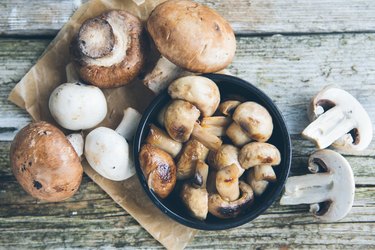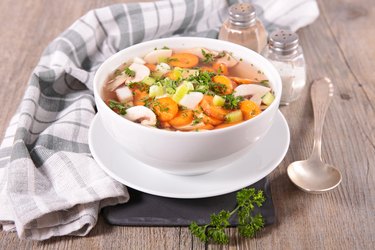
Who loves to sit down at the dinner table, fork in hand, faced with a teeny tiny portion of meat and potatoes? Maybe even a minuscule side of caesar salad? Wait — are those crickets in the background?
No one wants to walk away from a meal feeling hungry, which can happen with smaller portions. If you're on a weight-loss diet, you should still leave the table satisfied, even if you may not be 100 percent stuffed. But your satiety all comes down to your ingredients and your creativity.
Video of the Day
Video of the Day
If you're in need of some inspiration, look no further. We've gathered tips from several registered dietitians to give you the skinny on eating more food for less calories — yes, you read that right: more for less.
Volume Eating 101
Keto, paleo, vegan and now volume eating, too? How many more diets can we possibly commit to memory? Well, volume eating isn't exactly a diet per se — it's more like a clever eating strategy.
Volume eating involves strategically choosing ingredients and foods that are higher in surface area but low in calories. Luckily, many high-volume foods, like leafy greens, fruits, vegetables, lean proteins and single-ingredient carbohydrates are also rich in vitamins and nutrients.
"Eating foods with more volume can help you feel more satisfied," says Bonnie Taub-Dix, RDN, creator of BetterThanDieting.com and author of Read It Before You Eat It: Taking You From Label to Table.
"The key is not just adding volume though, but also adding value. Many nutrient-rich foods, like a bounty of fruits and veggies, are also rich in filling fiber," Taub-Dix says. This nutrient keeps your blood sugar stable, helping you stay satiated well after your meal, according to the Academy of Nutrition and Dietetics.
Swapping some of your more calorie-dense, low-nutrition foods for high-volume options is a great way to stick to your calorie deficit or just eat more throughout your day. If you need some meal prep inspiration, consider these seven helpful hacks.
Related Reading
1. Swap Meat for Mushrooms

Although the occasional hamburger never hurts, red meat can be high in fat and calories. While substituting some of your red meat for lean protein (like poultry) is always a good idea, you can also try swapping one of your daily meat portions with mushrooms, oatmeal or tofu, recommends Shena Jaramillo, RD.
"These [foods] all provide a texture [like meat] and can easily take on the flavor of whatever meat dish you are creating," Jaramillo says. "They will maintain the volume of the dish, while significantly reducing the calories."
Mixing half a ground beef portion with mushrooms or oatmeal is an excellent way to cut calories, while maintaining the density and size of your burger.
Concerned About Your Total Protein Intake?
While making one of these calorie-friendly swaps will bring down the total protein value of your meal, that probably won't be an issue, considering most Americans get enough protein each day, according to the Mayo Clinic.
2. Add Cauliflower to Your Breakfast Smoothie
What makes a smoothie more filling than juice? It's all in the density. Smoothies retain plants' fiber, making them more satisfying than your average green juice, according to the University of Washington. But smoothies are also usually blended with a thickening ingredient, like Greek yogurt, peanut butter or frozen banana, giving the drink more volume.
We all love a few spoonfuls of peanut butter in our smoothie but nut butters can pack on calories without contributing much volume. To retain the healthy fat in your smoothie, consider swapping one spoonful of nut butter for some cauliflower, suggests Maryann Walsh, RD, the owner of Walsh Nutrition Consulting.
You can also switch your frozen banana for a cup of frozen cauli. Bananas are certainly a healthy fruit but will add quite a bit of sugar and carbs to your drink, Walsh says. Cut your usual banana serving in half and swap with cauliflower to keep your smoothie or acai bowl creamy but lower in sugar.
3. Mix Veggies Into Your Refined Carbs
Eating a bowl of cauliflower rice or zoodles may not leave you totally satiated. But these veggie-based alternatives can come in handy if you want to trim the overall calories of your meals.
Instead of swapping all your rice or pasta with vegetables, go half and half, Jaramillo says. Mixing zucchini noodles into your spaghetti or cauliflower rice into your risotto can help your bowl stay full, while minimizing the overall calories and maintaining the flavor/texture of the dish.
Adding vegetables will also increase the overall fiber of your meal, Jaramillo says, which refined pasta and rice don't usually provide. That's a good thing, since increasing fiber will keep you full for longer.
4. Add Egg Whites to Your Breakfast
Oatmeal is a popular breakfast food, since the grain is like a blank canvas, mixing well with just about any ingredients you add to the bowl (yep, even savory oatmeal is a thing).
For all the positives oatmeal has to offer, it does have one downside: It's low in protein. While most Americans do get plenty of protein each day (as mentioned above), you may want to space your intake evenly across your meals, as the nutrient is excellent for maintaining satiety throughout the day, according to the Mayo Clinic.
Egg whites are an excellent, low-calorie method to add both protein and volume to your dish, Jaramillo says. Minimize your oatmeal portion and cook the oats with egg whites instead. As they heat up, the whites will puff up, giving you more surface area. Plus, they're practically flavorless, which means you can serve your oatmeal sweet, too, without any eggy taste.
Oatmeal isn't the only dish that can be inflated with egg whites, though. You can also add them to cream of rice, or swap one of the eggs in your two-egg omelette with egg whites to bring down the calories but increase the overall size.
Related Reading
5. Eat Soup With Your Meal

Eating a vegetable-based soup with your meal is another way to increase your post-meal fullness, while bringing down your total calories, Jaramillo says. Swapping some of your carbs or meat with a nutrient-dense veggie soup can give your meal a boost of filling fiber. Plus, the warm water will fill your stomach and keep you feeling more hydrated.
Eating soup more frequently has even been associated with a reduced risk of obesity, according to a September 2013 study published in PLOS One. A previous November 2008 study published in Appetite even found that eating soup before a meal can help reduce overall calorie intake.
But of course, these methods aren't set in stone. While they may work for some, others may not see the same results. Nevertheless, there's no harm in adding a vitamin- and nutrient-rich, fiber-filled vegetable soup to your weekly menu.
6. Mix Your Favorite Dressing
Ever seen a salad that's somehow more caloric than a burger? The dressing is probably the culprit. Salad dressings can be high in fat and calories but don't contribute much nutrition or surface area to your meal.
But that doesn't mean you have to abandon your favorite salad dressing completely. Instead, mix a half serving of your go-to dressing with a low-calorie vinegar, like balsamic vinegar, apple cider vinegar or red wine vinegar, Taub-Dix says. This will bring the calories of your meal down but will keep your salad full of flavor.
7. Top With Sauerkraut
It's no secret that sauerkraut is a nutritional powerhouse. The pickled cabbage is a great source of vitamin C, vitamin K and fiber, according to the Academy of Nutrition and Dietetics. But the traditional German fermented food has also been associated with gut-friendly benefits due to its probiotic content.
Sauerkraut is also extremely low in calories, packing on only 27 calories per cup, making it a great topping to just about any food. On taco night, swap some of your ground beef portion with sauerkraut or pile some of the pickled veggie onto a baked potato instead of sour cream, Jaramillo suggests. This will add volume and nutrients, while cutting some calories from your dish.
- Mayo Clinic: "Are You Getting Too Much Protein?"
- Academy of Nutrition and Dietetics: "Fiber"
- PLOS One: "Soup Consumption Is Associated with a Reduced Risk of Overweight and Obesity but Not Metabolic Syndrome in US Adults: NHANES 2003–2006"
- Appetite: "Soup Preloads in a Variety of Forms Reduce Meal Energy Intake"
- Academy of Nutrition and Dietetics: "DIY Kitchen: Sauerkraut"
- University of Washington: "Juicing vs. Blending – What’s the Difference?"
- Mayo Clinic: "Mayo Clinic Minute: Foods to Help you Feel Full"